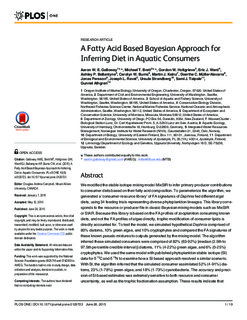| dc.contributor.author | Galloway, Aaron W.E. | |
| dc.contributor.author | Brett, Michael T. | |
| dc.contributor.author | Holtgrieve, Gordon W. | |
| dc.contributor.author | Ward, Eric J. | |
| dc.contributor.author | Ballantyne, Ashley P. | |
| dc.contributor.author | Burns, Carolyn W. | |
| dc.contributor.author | Kainz, Martin J. | |
| dc.contributor.author | Müller-Navarra, Doerthe C. | |
| dc.contributor.author | Persson, Jonas | |
| dc.contributor.author | Ravet, Joseph L. | |
| dc.contributor.author | Strandberg, Ursula | |
| dc.contributor.author | Taipale, Sami J. | |
| dc.contributor.author | Alhgren, Gunnel | |
| dc.date.accessioned | 2018-07-31T12:13:05Z | |
| dc.date.available | 2018-07-31T12:13:05Z | |
| dc.date.created | 2015-10-11T12:09:25Z | |
| dc.date.issued | 2015 | |
| dc.identifier.citation | PLoS ONE. 2015, 10:e0129723 (6), 19. | nb_NO |
| dc.identifier.issn | 1932-6203 | |
| dc.identifier.uri | http://hdl.handle.net/11250/2506989 | |
| dc.description.abstract | We modified the stable isotope mixing model MixSIR to infer primary producer contributions to consumer diets based on their fatty acid composition. To parameterize the algorithm, we generated a ‘consumer-resource library’ of FA signatures of Daphnia fed different algal diets, using 34 feeding trials representing diverse phytoplankton lineages. This library corresponds to the resource or producer file in classic Bayesian mixing models such as MixSIR or SIAR. Because this library is based on the FA profiles of zooplankton consuming known diets, and not the FA profiles of algae directly, trophic modification of consumer lipids is directly accounted for. To test the model, we simulated hypothetical Daphnia comprised of 80% diatoms, 10% green algae, and 10% cryptophytes and compared the FA signatures of these known pseudo-mixtures to outputs generated by the mixing model. The algorithm inferred these simulated consumers were comprised of 82% (63-92%) [median (2.5th to 97.5th percentile credible interval)] diatoms, 11% (4-22%) green algae, and 6% (0-25%) cryptophytes. We used the same model with published phytoplankton stable isotope (SI) data for δ13C and δ15N to examine how a SI based approach resolved a similar scenario. With SI, the algorithm inferred that the simulated consumer assimilated 52% (4-91%) diatoms, 23% (1-78%) green algae, and 18% (1-73%) cyanobacteria. The accuracy and precision of SI based estimates was extremely sensitive to both resource and consumer uncertainty, as well as the trophic fractionation assumption. These results indicate that when using only two tracers with substantial uncertainty for the putative resources, as is often the case in this class of analyses, the underdetermined constraint in consumerresource SI analyses may be intractable. The FA based approach alleviated the underdetermined constraint because many more FA biomarkers were utilized (n < 20), different primary producers (e.g., diatoms, green algae, and cryptophytes) have very characteristic FA compositions, and the FA profiles of many aquatic primary consumers are strongly influenced by their diets. | nb_NO |
| dc.language.iso | eng | nb_NO |
| dc.publisher | Public Library of Science | nb_NO |
| dc.rights | CC0 1.0 Universal (CC0 1.0) Public Domain Dedication | * |
| dc.rights.uri | https://creativecommons.org/publicdomain/zero/1.0/ | * |
| dc.title | A fatty acid based bayesian approach for inferring diet in aquatic consumers | nb_NO |
| dc.type | Journal article | nb_NO |
| dc.type | Peer reviewed | nb_NO |
| dc.description.version | publishedVersion | nb_NO |
| dc.source.pagenumber | 19 | nb_NO |
| dc.source.volume | 10:e0129723 | nb_NO |
| dc.source.journal | PLoS ONE | nb_NO |
| dc.source.issue | 6 | nb_NO |
| dc.identifier.doi | 10.1371/journal.pone.0129723 | |
| dc.identifier.cristin | 1279800 | |
| dc.relation.project | National Science Foundation: 0925718 | nb_NO |
| dc.relation.project | National Science Foundation: 0742559 | nb_NO |
| cristin.unitcode | 7464,30,19,0 | |
| cristin.unitname | Ferskvannsøkologi | |
| cristin.ispublished | true | |
| cristin.fulltext | original | |
| cristin.qualitycode | 1 | |

